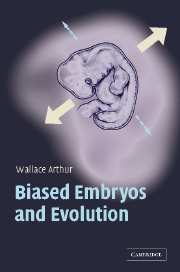Book contents
- Frontmatter
- Contents
- Preface
- Acknowledgements
- 1 The microscopic horse
- 2 What steers evolution?
- 3 Darwin: pluralism with a single core
- 4 How to build a body
- 5 A brief history of the last billion years
- 6 Preamble to the quiet revolution
- 7 The return of the organism
- 8 Possible creatures
- 9 The beginnings of bias
- 10 A deceptively simple question
- 11 Development's twin arrows
- 12 Action and reaction
- 13 Evolvability: organisms in bits
- 14 Back to the trees
- 15 Stripes and spots
- 16 Towards ‘the inclusive synthesis’
- 17 Social creatures
- Glossary
- References
- Index
10 - A deceptively simple question
Published online by Cambridge University Press: 02 December 2009
- Frontmatter
- Contents
- Preface
- Acknowledgements
- 1 The microscopic horse
- 2 What steers evolution?
- 3 Darwin: pluralism with a single core
- 4 How to build a body
- 5 A brief history of the last billion years
- 6 Preamble to the quiet revolution
- 7 The return of the organism
- 8 Possible creatures
- 9 The beginnings of bias
- 10 A deceptively simple question
- 11 Development's twin arrows
- 12 Action and reaction
- 13 Evolvability: organisms in bits
- 14 Back to the trees
- 15 Stripes and spots
- 16 Towards ‘the inclusive synthesis’
- 17 Social creatures
- Glossary
- References
- Index
Summary
Following the mind games of the last two chapters, we are now as familiar with adaptive landscapes as with real ones. But, taking a step backwards, what, in the first place, is this thing called ‘adaptation’? There is a huge literature on this, both scientific and philosophical. Most of it I will pass by as it is not central to my task herein. But there is one particular issue that we now need to confront: how inclusive is ‘adaptation’? More specifically, does ‘adaptation’ include both external and internal aspects? Does it include both the ‘fit’ between a bird's beak and its food supply (external) and the ‘fit’ between one of its bones and another interconnecting one (internal)? At the molecular level, does it include both the enzymes that digest a horse's food (external, because the digestive tract is a tube of the external environment projecting through an animal from mouth to anus) and the interplay between a signalling molecule and its receptor deep within the horse embryo (internal)?
The external aspect of adaptation is, clearly, adaptation to the environment; so it is often referred to as ecological adaptation. The internal aspect is adaptation of one body part to another; so it is often referred to as coadaptation. But unfortunately, the casual use of ‘adaptation’, naked and unqualified, is common in the biological literature. When authors use this word in an unqualified way, what do they mean? Specifically, are they using it as shorthand for ecological adaptation, or are they using it in a broader way, to include coadaptation too?
Regrettably, the answer depends on the author. Different authors use ‘adaptation’ in different ways.
- Type
- Chapter
- Information
- Biased Embryos and Evolution , pp. 116 - 126Publisher: Cambridge University PressPrint publication year: 2004



